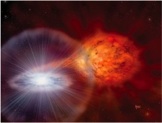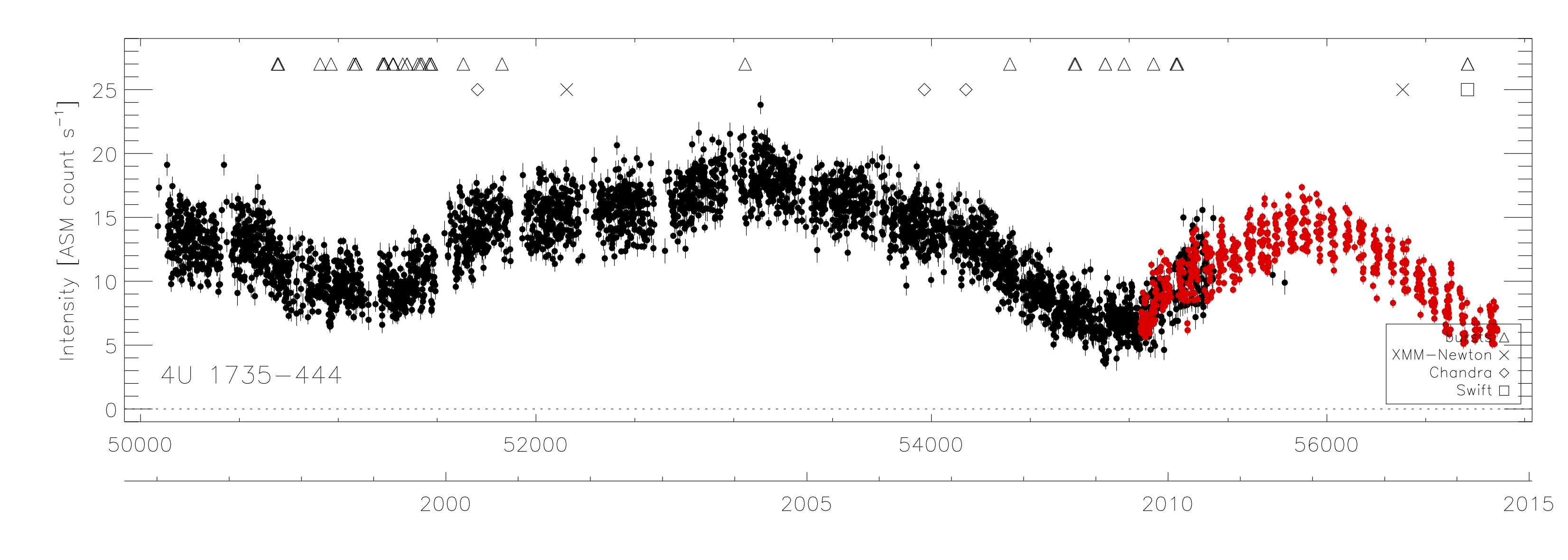

External links |
Public /
4U 1735–444This page describes a long-term project to track the burst behaviour in the low-mass X-ray binary 4U 1735-444, with the objective of triggering XMM-Newton AO13 observations (obs. ID #07446301, PI: Galloway; see the proposal) to gather many photospheric radius-expansion (PRE) bursts, and search for spectral features at the peak of the bursts. What's new
Background4U 1735-444 (V926 Sco) is a bursting NS in a 4.654-hr binary orbit with a low-mass companion. In observations by the Rossi X- ray Timing Explorer (RXTE) PCA and the BeppoSAX WFC1 between 1996–2012, 4U 1735−444 displayed episodic bursting behaviour at low persistent flux levels, with short bursts (rise times $ \le 2 $ s, and mean timescale of $ \tau = 3.7 \pm 0.8 $ s) characteristic of H-poor fuel. A significant fraction (73% of the bursts observed with RXTE; Galloway et al., 2008) of these bursts exhibited radius-expansion. In the last two decades, 4U 1735−444 has only exhibited bursts in the low phase of its long-term persistent flux variation (Fig. 1). With the persistent flux measured by MAXI decreasing steadily from a maximum in 2012, it was predicted that the source would soon return to the persistent flux level at which it is expected to burst.  Figure 1: Long-term flux history and burst behaviour of 4U 1735−444. Plotted are 2–10 keV intensity measurements by RXTE/ASM (black symbols), along with the measurements in the same band made by MAXI (rescaled by a factor of 24.77 to match the ASM measurements where they overlap; red symbols). The times of thermonuclear bursts detected by RXTE/PCA and BeppoSAX/WFC (open triangles), as well as the epochs of observations by XMM-Newton, Chandra and Swift (crosses, open diamonds, and open squares respectively) are indicated. Note that (with one exception) the burst behaviour is restricted to the epochs of low peak flux between 1997–2001, 2007–10, and 2014–. The decrease in persistent intensity measured by MAXI from 2012 suggested that 4U 1735−444 would return to a low-intensity, bursting state, which was confirmed by Swift in 2014 Feb. last updated 2014 Aug 29 Return to the burst stateThis prediction was borne out when the source was observed with Swift in 2014 February, prior to one of the observing windows for XMM-Newton. The 40-ks observation revealed five bursts (Figure 2). We detected with high confidence 5 events with profiles matching type-I (thermonuclear) X-ray bursts, at February 23.07431, 23.60896, 23.67834, 24.340947 and 24.597133. These are the first bursts observed from the source since 2010, which confirms it is once again in a low-accretion rate, bursting state. Figure 2: Swift 0.3–10 keV intensity of 4U 1735-444 during the observation in February 2014. Click-and-drag on the plot to zoom in. Double click to zoom out to the full range. The raw data can be downloaded here: swift_0.5s.csv Notably, the closest pair were separated by 1.67 hr. Our XMM-Newton trigger criteria require regular bursting at 1.5 hr (or more frequently), in order to accumulate sufficient signal-to-noise in the peak of the bursts to allow a deep search for spectral features. Although the shortest observed interval did not meet the trigger criteria, we investigated all five bursts detected in the Swift observation to determine if they were consistent with regular bursting. We could not identify any regular recurrence time that was consistent with the observed times of bursts. The lack of regularity can be illustrated by the last pair of bursts that was observed, separated by 6.15 hours, or 3.69 times the separation of the closest pair. If the bursts were recurring regularly, the separation of any pair of bursts should be roughly an integer number of burst recurrence time (which is the shortest separation measurable). We conclude that, although 4U 1735-444 is bursting once more, the burst pattern is not sufficiently frequent nor regular to trigger the XMM-Newton observation. We hope to monitor the burst behaviour through the low state with the hopes of meeting the trigger condition in future. In the meantime, we will continue with our analysis of the Swift data, to determine the persistent intensity, and hence the accretion rate. This will be compared to our previous sample of observations to assess the long-term stability of the burst behaviour in response to the accretion rate. We will also carry out time-resolved spectroscopy of the bursts, with the goal of determining the energetics and assessing whether or not they exhibit photospheric radius-expansion. back to the home page |